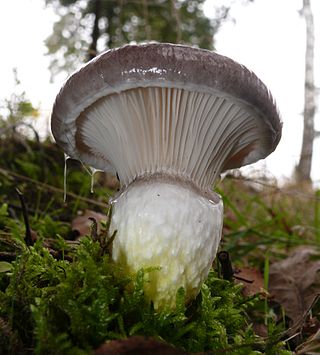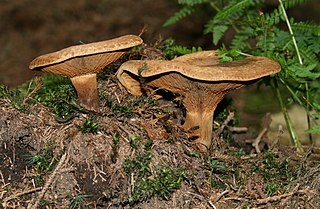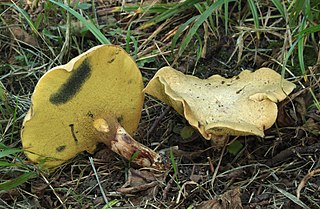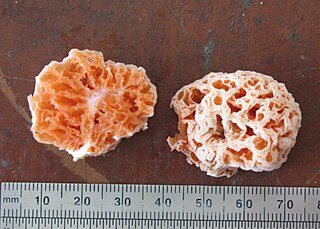
The Boletales are an order of Agaricomycetes containing over 1300 species with a diverse array of fruiting body types. The boletes are the best known members of this group, and until recently, the Boletales were thought to only contain boletes. The Boletales are now known to contain distinct groups of agarics, puffballs, and other fruiting-body types.

The Boletaceae are a family of mushroom-forming fungi, primarily characterised by small pores on the spore-bearing hymenial surface, instead of gills as are found in most agarics. Nearly as widely distributed as the agarics, the family is renowned for hosting some prime edible species highly sought after by mushroom hunters worldwide, such as the cep or king bolete . A number of rare or threatened species are also present in the family, that have become the focus of increasing conservation concerns. As a whole, the typical members of the family are commonly known as boletes.

Strobilomyces is a genus of boletes. The only well-known European species is the type species S. strobilaceus, known in English as "old man of the woods".

Boletus is a genus of mushroom-producing fungi, comprising over 100 species. The genus Boletus was originally broadly defined and described by Carl Linnaeus in 1753, essentially containing all fungi with hymenial pores instead of gills. Since then, other genera have been defined gradually, such as Tylopilus by Petter Adolf Karsten in 1881, and old names such as Leccinum have been resurrected or redefined. Some mushrooms listed in older books as members of the genus have now been placed in separate genera. These include such as Boletus scaber, now Leccinum scabrum, Tylopilus felleus, Chalciporus piperatus and Suillus luteus. Most boletes have been found to be ectomycorrhizal fungi, which means that they form a mutualistic relationship with the roots system of certain kinds of plants. More recently, Boletus has been found to be massively polyphyletic, with only a small percentage of the over 300 species that have been assigned to Boletus actually belonging there and necessitating the description and resurrection of many more genera.

Hygrophoropsis aurantiaca, commonly known as the false chanterelle, is a species of fungus in the family Hygrophoropsidaceae. It is found across several continents, growing in woodland and heathland, and sometimes on woodchips used in gardening and landscaping. Fruit bodies (mushrooms) are yellow–orange, with a funnel-shaped cap up to 8 cm across that has a felt-like surface. The thin, often forked gills on the underside of the cap run partway down the length of the otherwise smooth stipe. Reports on the mushroom's edibility vary – it is considered poisonous, but has historically been eaten in parts of Europe and the Americas.

Gomphidius is a genus of mushrooms, commonly known as spike-caps, that are members of the Boletales, or pored fungi. They appear to have gill-like structures which resemble those of agarics, however the similarity is superficial only. The best-known member is the slimy spike-cap. The genus has a widespread distribution, especially in north temperate areas, and contains 10 species.

The Paxillaceae are a family of mushroom-forming fungi bearing close affinity to the boletes. Collectively, the family contains nine genera and 78 species. The type genus is Paxillus, containing fungi with decurrent gills, and Gyrodon, which has members with decurrent pores, among others. French mycologist René Maire had erected the family in 1902, placing it between the agarics and boletes and recognizing the groups' similarities with the latter group. Maire's usage of the name was later deemed to be invalid, and the genus authority is attributed to Johannes Paulus Lotsy. Molecular research confirms the relations of Gyrodon, with the decurrent-pored mushroom G. lividus, Paragyrodon, with the type species P. sphaerosporus, and Paxillus as sister groups, together lying near the base of a phylogenetic tree from which the genus Boletus arises. The name Gyrodontaceae, published by Belgian botanist Paul Heinemann in 1951, is considered synonymous with Paxillaceae.

Chroogomphus is a genus of mushrooms commonly known as pine-spikes or spike-caps based on their shape and because they are often found growing in association with pine trees. The genus is distributed throughout the Northern Hemisphere including North America and Eurasia.

The Suillaceae are a family of fungi in the order Boletales, containing the boletus-like Suillus, the small truffle-like Truncocolumella, as well as the monotypic genus Psiloboletinus. As of 2008, there are 54 species in the family. Gastrosuillus, once considered a distinct genus, has been shown with molecular analysis to be a recent evolutionary derivative of Suillus. Fuscoboletinus, described by Pomerleau and Smith in 1962, has also been subsumed into Suillus.

Gyrodon lividus, commonly known as the alder bolete, is a pored mushroom bearing close affinity to the genus Paxillus. Although found predominantly in Europe, where it grows in a mycorrhizal association with alder, it has also recorded from China, Japan and California. Fruit bodies are distinguished from other boletes by decurrent bright yellow pores that turn blue-grey on bruising. G. lividus mushrooms are edible.

Chalciporus is a genus of fungi in the family Boletaceae. There are approximately 25 species in the genus.

Phlebopus is a genus of fungi in the family Boletinellaceae. The genus has a widespread distribution in subtropical and pantropical regions, and contains 12 species. The species are saprobic, with some possibly able to form mycorrhizae with exotic trees in certain conditions. It contains the gigantic Phlebopus marginatus, the cap of which can reach 1 m (3.3 ft) in diameter.

Hygrophoropsis is a genus of gilled fungi in the family Hygrophoropsidaceae. It was circumscribed in 1888 to contain the type species, H. aurantiaca, a widespread fungus that, based on its appearance, has been affiliated with Cantharellus, Clitocybe, and Paxillus. Modern molecular phylogenetic analysis shows that the genus belongs to the suborder Coniophorineae of the order Boletales.

Rubroboletus rhodoxanthus is a species of bolete in the family Boletaceae, native to Europe. Previously known as Boletus rhodoxanthus, it was transferred in 2014 to the newly erected genus Rubroboletus, based on DNA data.

Spongiforma is a genus of sponge-like fungi in the family Boletaceae. Newly described in 2009, the genus contains two species: S. thailandica and S. squarepantsii. The type species S. thailandica is known only from Khao Yai National Park in central Thailand, where it grows in soil in old-growth forests dominated by dipterocarp trees. The rubbery fruit bodies, which has a strong odour of coal-tar similar to Tricholoma sulphureum, consists of numerous internal cavities lined with spore-producing tissue. S. squarepantsii, described as new to science in 2011, is found in Malaysia. It produces sponge-like, rubbery orange fruit bodies with a fruity or musky odour. These fruit bodies will—like a sponge—resume their original shape if water is squeezed out. The origin of the specific name derives from its perceived resemblance to the cartoon character SpongeBob SquarePants. Apart from differences in distribution, S. squarepantsii differs from S. thailandica in its colour, odour, and spore structure.

Boletinellus merulioides, commonly known as the ash-tree bolete, is a species of bolete fungus in the family Boletinellaceae. Described as new to science in 1832, it is found in Asia and eastern North America, where it grows on the ground near ash trees.

Aphroditeola is an agaric fungal monotypic genus that produces pink cantharelloid fruit bodies on coniferous forest floors. The lamellae are forked and typically the fruit bodies have a fragrant odor described as candy-like, cinnamon-like or pink bubble gum-like.

Sclerodermatineae is a suborder of the fungal order Boletales. Circumscribed in 2002 by mycologists Manfred Binder and Andreas Bresinsky, it contains nine genera and about 80 species. The suborder contains a diverse assemblage fruit body morphologies, including boletes, gasteroid forms, earthstars, and puffballs. Most species are ectomycorrhizal, although the ecological role of some species is not known with certainty. The suborder is thought to have originated in the late Cretaceous (145–66 Ma) in Asia and North America, and the major genera diversified around the mid Cenozoic (66–0 Ma).

Imperator luteocupreus is a species of bolete fungus in the family Boletaceae. It is native to southern Europe, where it is found under chestnut (Castanea) and oak (Quercus). Although it was originally described in genus Boletus, it was placed in the new genus Imperator in 2015, based on phylogenetic inferences.

Leucogyrophana is a genus of fungi in the family Hygrophoropsidaceae. The genus was erected in 1958 to accommodate the species then known as Merulius molluscus. Several more species were described, but DNA testing in 2001 found that L. mollusca was isolated genetically from the others, and most closely related instead to Hygrophoropsis.




















